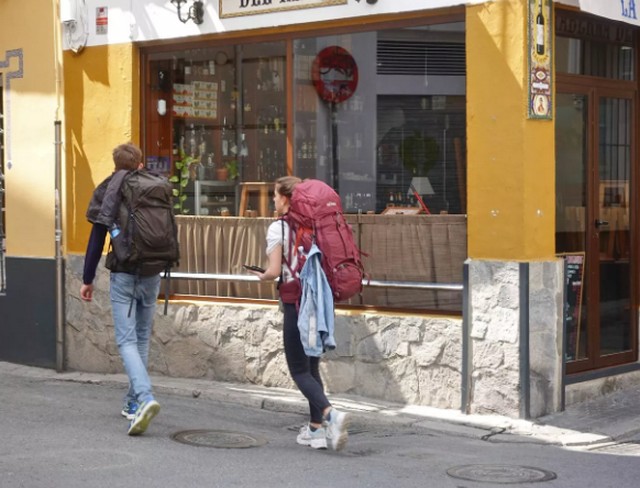Embarking on an international adventure is an exciting prospect, and choosing the right backpack is paramount to a smooth and enjoyable journey. More than just a bag, your backpack is your mobile home, carrying your essentials as you navigate bustling cities, serene landscapes, and everything in between. When selecting a backpack for travel abroad, it's crucial to consider a few key factors: materials, size, durability, and sustainability.
Materials: The Foundation of Your Pack
The material of your backpack dictates its weight, water resistance, and overall feel.
 |
| (Picture: thesavvybackpacker.com) |
Common materials include:
- Nylon: A very popular choice due to its excellent strength-to-weight ratio. Different types of nylon, such as Ripstop Nylon, offer increased tear resistance without adding significant bulk.
- Polyester: Often more affordable than nylon, polyester is also durable and generally resistant to stretching and shrinking. However, it can be slightly heavier and less abrasion-resistant than nylon.
- Cordura Fabric: Known for its exceptional toughness and abrasion resistance, Cordura is a brand of nylon fabric that comes in various deniers (a unit of linear mass density of fibers). Higher denier Cordura fabrics offer superior durability, making them ideal for rugged travel.
- Canvas: While offering a classic aesthetic, the canvas can be heavier and less water-resistant than synthetic materials. However, waxed canvas can provide good water repellency and a unique, rugged look.
When considering materials, also look for coatings like Polyurethane (PU) or Durable Water Repellent (DWR) finishes, which enhance water resistance, protecting your belongings from unexpected downpours.
Size: Finding Your Sweet Spot
Backpack size is typically measured in liters, and the ideal capacity depends heavily on the duration of your trip and your packing style.
- Carry-on Friendly (20-45 liters): For shorter trips or minimalist packers, a backpack in this range can often fit in overhead compartments, saving you time and money on checked luggage. Look for designs with full-zip openings for easy access.
- Medium-Sized (45-65 liters): This is a versatile range suitable for longer trips (1-3 weeks) where you need to carry more clothing and gear. These often require checking in, so consider external compression straps to cinch down your load.
- Larger Packs (65+ liters): Primarily for extended expeditions, multi-month backpacking trips, or specific gear-heavy adventures. While offering ample space, they can be cumbersome for navigating crowded areas and are always checked baggage.
Remember that airline carry-on regulations vary, so always double-check the specific dimensions allowed by your chosen airline before you fly.
Durability: Built to Last
Your travel backpack will likely endure significant wear and tear, from being tossed into baggage holds to navigating rough terrain. Key aspects of durability include:
- Stitching: Look for reinforced stitching, especially at stress points like shoulder strap attachments, hip belt connections, and grab handles. Bar-tacking (a type of reinforced stitching) is a good indicator of quality.
- Zippers: High-quality zippers are crucial. YKK zippers are widely regarded as an industry standard for their reliability and smooth operation. Opt for larger, self-repairing zippers where possible.
- Hardware: Buckles, adjusters, and other plastic or metal components should feel robust and not flimsy. Duraflex and ITW Nexus are examples of reputable hardware brands.
- Internal Frame: Many travel backpacks feature an internal frame, typically made of aluminum or high-density plastic, to distribute weight efficiently and maintain the pack's structure. A well-designed frame enhances comfort and durability.
Sustainability: Traveling Responsibly
As global awareness of environmental impact grows, so does the demand for sustainable products. When considering a backpack, you might look for:
- Recycled Materials: Many brands are now incorporating recycled nylon or polyester into their products, reducing reliance on virgin plastics.
- Bluesign® Approved Fabrics: This certification ensures that fabrics are manufactured using processes that minimize environmental impact and are safe for workers and consumers.
- PFC-Free DWR Coatings: Per- and polyfluorinated chemicals (PFCs) are often used in DWR coatings but can be harmful to the environment. Opting for PFC-free alternatives is a more sustainable choice.
- Ethical Manufacturing Practices: Some brands are transparent about their supply chains and demonstrate a commitment to fair labor practices and safe working conditions. Researching a brand's corporate responsibility initiatives can provide valuable insight.
Brands to Consider (Examples, Not Recommendations):
Many reputable brands offer a range of backpacks suitable for international travel, each with its unique design philosophy and features. Some examples that are often discussed for their quality and innovation include:
- Osprey: Known for their comfortable suspension systems, well-organized compartments, and comprehensive warranty programs.
- Deuter: Often praised for their robust construction, ventilation systems, and commitment to sustainable practices.
- Eagle Creek: Popular for their durable travel gear, including many travel-specific backpack designs with features like security zippers and versatile carrying options.
- Tortuga: Specializing in carry-on-friendly travel backpacks, often with a focus on maximizing usable space and providing easy access to belongings.
- Patagonia: Recognized for their commitment to environmental sustainability, using recycled materials, and producing durable outdoor gear suitable for various travel styles.
By carefully considering materials, size, durability, and sustainability, you can select a backpack that not only meets your travel needs but also aligns with your values, ensuring a comfortable and responsible journey abroad. Happy travels!


0 Komentar